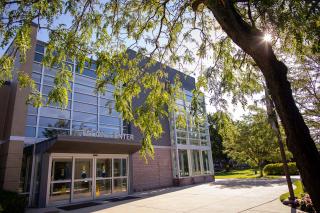How to Keep Your Student Loans in Good Standing
Fri: 8:00 am - 3:00 pm
You’re not alone if you need to borrow money to pay for your education. Many students at Coppin and other universities decide to apply for federal financial aid, scholarships, and other funding opportunities.
The Office of Financial Aid encourages all students to research other funding sources, including federal, state, local, private, and public grants, scholarships, student employment, as well as employer tuition assistance. We keep a database of scholarships and other funding, but it’s just as important for you to do your own research.
What all student borrowers should know
Working with student borrowers, our office has a lot of experience understanding what every student borrower needs to know. The biggest point to remember is that you must repay federal student loans. When you don’t repay a loan in repayment, it can put your loan in default.
The federal government does any and everything to get federal monies loaned to borrowers, and are well within their rights to seize your tax refund, garnish wages, and place liens on your property—all of which can damage your credit. Read on to learn how you can make smart decisions about your federal financial aid.
Borrowing and managing student and parent loans
Students and families who take out federal school loans are borrowing money to pay for school. Remember, any money you borrow must be repaid—even if you do not finish school. It is also important to remember that when you borrow money, you are agreeing to a contract for how you get the money, what it can be used for, how you repay it, and what your options are if you cannot or do not pay your loans back.
School can get expensive, so it may be tempting to borrow more than you need. We get it—but strongly encourage you to only accept loans based on actual need.
When your loans enter repayment, you will have to pay back everything you borrowed plus interest. Borrowing more than you need may lead to higher monthly payments for a longer time. Remember, you must repay your loans even if you do not finish your program and/or degree.
View and manage your loans through the National Student Loan Data System (NSLDS). Be ready with your FSA User ID because you can use it to login to NSLDS too. You can also contact the Federal Student Aid Information Center (FSAIC) via live chat, phone, or email.
When you have multiple loans, each loan may be with a different loan service provider. A loan servicer is a company the federal government assigns to handle the billing and repayment of your loans. Some well-known providers are FedLoan Servicing, Mohela, Nelnet, and ECSI, along with several others. Be sure you know who your providers are and how to contact them. The NSLDS is a good place to start.
Loan consolidation means to combine multiple loans into one loan so you have one bill and repayment plan. Borrowers must have at least one Direct Loan or Federal Family Education Loan (FFEL) to qualify for consolidation through a Direct Consolidation Loan. You may also qualify if you have Federal Stafford Subsidized, Unsubsidized, Perkins loans, or loans from another school attended in addition to Coppin.
Loans must be in grace, repayment, deferment, or default status to qualify for consolidation. They cannot be in in-school status. Consider learning more about loan consolidation and if it’s right for you.
Repaying student and parent loans
Repayment is the period of time where you must pay your school loans back. There are often several different options for repayment. Be sure to work with your loan providers for a repayment option that fits your employment status and other needs.
First, your loan service provider contacts you with the date your loan repayment starts and how much you owe. They usually contact you when one of the following events happens:
- Graduation
- Withdrawal from school
- Drop below half-time enrollment
These events start the 6-month grace period before you must start repaying your loans. During the grace period, your subsidized loans don’t earn interest. Unsubsidized loans do earn interest, which is then added to your loan balance when it enters repayment. Repayment begins the day after your grace period ends, and your first payment is due within 60 days. Talk with your loan service provider about extending your grace period, if needed.
Each loan only has one grace period. You may be eligible for loan deferment if you re-enroll in school, but you will immediately return to repayment after you leave school. There are also options to pay your loans while you are enrolled in school. Contact your loan service provider to learn more.
Loan service providers commonly offer different types of repayment plans. Let’s look at the most common ones.
Standard repayment
With this plan, you’ll pay a fixed amount each month until your loans are paid in full. These plans often have a 10-year limit, so your monthly payments may be higher than other repayment plans, but you may pay less interest overall.
Graduated repayment
With this plan, you’ll start with a low payment that gradually increases every two years. These plans last for 10 years and can be a good choice if you expect steady salary increases.
This plan still earns interest that is part of your monthly payment. However, even with interest and graduated payments, you will not have any single payment be 3x more than any other payment.
Extended repayment
With this plan, you’ll pay an annual fixed amount or graduated amount over 25 years. This plan allows you to make smaller monthly payments over a longer period. Remember, even though your monthly payments may be smaller, you will pay more than the total amount of your loan because it will earn interest during the entire repayment period.
To be eligible for an extended repayment plan, borrowers must have certain types of loans:
- $30,000 or more in outstanding Federal Family Education Loan (FFEL) loans and/or
- $30,000 or more in outstanding Direct Loans
Getting help for loan default
Everyone can fall on hard times, so it’s important to know what can happen if you are unable to pay your loans as agreed. Your loan service provider may be able to help, so do not wait to contact them if you are struggling to repay your bills.
When you accept your loans and sign your Master Promissory Note (MPN), you also agree to conditions for repaying your loan(s) on time. Failure to repay your loan(s) can result in loan default, and other consequences.
There are options to available to help you prevent default:
Deferment is a period of time that postpones your student loans payments. During deferment for subsidized loans, interest doesn’t accrue. Deferment is usually available for students enrolled in courses at least half-time.
Forbearance is a time period when your monthly loan payments are temporarily suspended or reduced due to financial hardships. Common hardships include medical expenses, financial difficulties, or loss of employment.
Repayment options are available. Changing your repayment plan can be helpful if your life circumstances change. There are no penalties for changing to a different repayment plan.
When you sign your Master Promissory Note (MPN) it becomes a binding legal document. This means, when you break the terms of the MPN, like repaying your loans on time, you are breaking the law. Any of the loan providers, managers or guarantors of your loans can take legal action against you to recover the money you owe.
Serious consequences of loan default include:
- Negative impact to your credit rating
- Wage garnishment
- Ineligibility for additional federal student aid
- Legal action
- Federal tax return garnishment
The Federal Student Aid (FSA) Ombudsman is a resource available to help students resolve disputes and problems regarding federal student loans. We also encourage you to reach out to your loan service provider.
Student Loan Default Rate at Coppin State University
Cohort Default Rate
In 2019 the default rate for borrowers at Coppin State University was 7%. A total of 1,005 Coppin State University students entered loan repayment in 2019. After three years, 7% of these students (71 out of 1,005) defaulted on their loans.
A cohort default rate (CDR) is the percentage of a school’s borrowers who enter repayment on certain Federal Family Education Loan (FFEL) Program or William D. Ford Federal Direct Loan (Direct Loan) Program loans during a particular federal fiscal year (FY), October 1 to September 30, and default or meet other specified conditions prior to the end of the second following fiscal year.
A student is considered to be in default on a student loan if they have not made a payment in more than 270 days. The official student loan default rate for a school is calculated by measuring how many students are in default three years after graduation. Note that the default rate only takes into account federal loans, not private.

